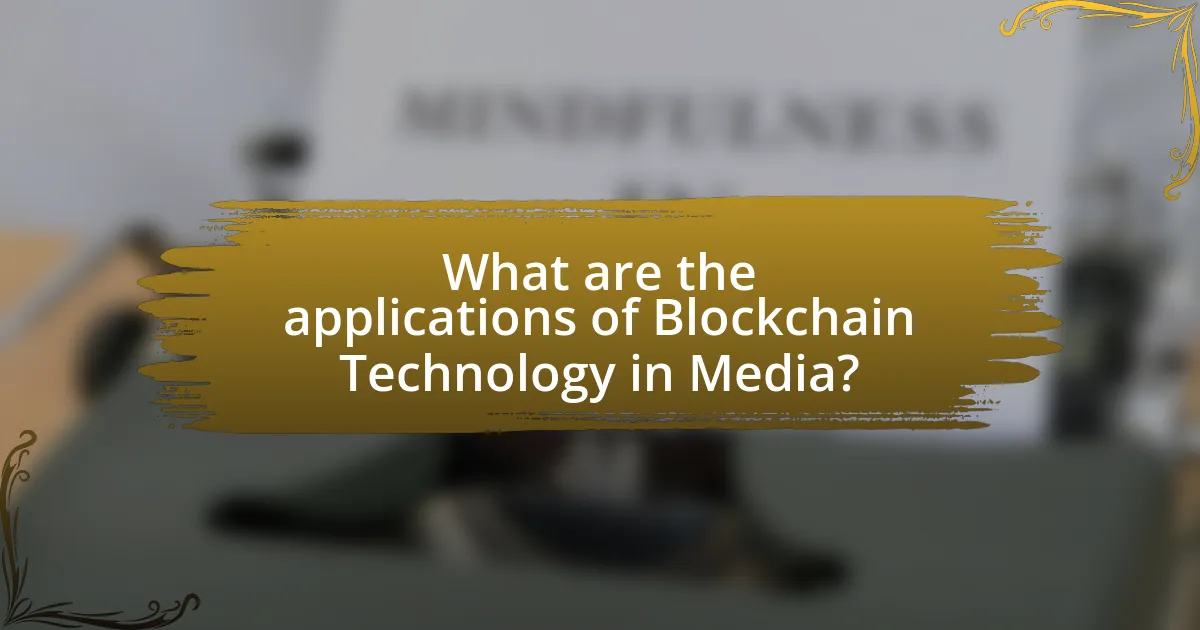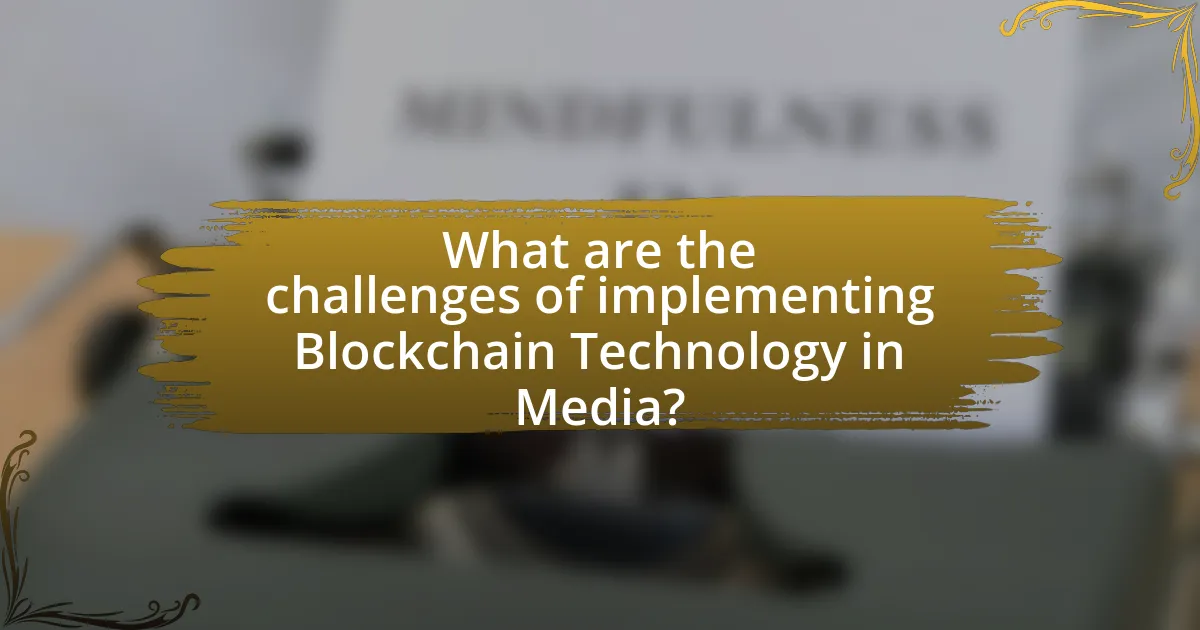Blockchain technology in media refers to the application of decentralized digital ledgers to improve transparency, security, and trust in media transactions and content distribution. This technology enables secure recording of data related to media assets, such as ownership rights and distribution history, while addressing issues like copyright infringement and revenue distribution. Key components include decentralization, immutability, transparency, and smart contracts, which collectively enhance accountability and reduce fraud. The article explores how blockchain facilitates fair compensation for creators, improves advertising transparency, and addresses challenges such as scalability and regulatory compliance, ultimately reshaping the media landscape by fostering a more equitable and trustworthy environment.

What is Blockchain Technology in Media?
Blockchain technology in media refers to the use of decentralized digital ledgers to enhance transparency, security, and trust in media transactions and content distribution. This technology allows for the secure recording of data related to media assets, such as ownership rights, distribution history, and content authenticity. For instance, platforms like Audius utilize blockchain to ensure artists receive fair compensation and maintain control over their work, thereby addressing issues of copyright infringement and revenue distribution. By providing an immutable record of transactions, blockchain fosters accountability and reduces the risk of fraud in the media industry.
How does Blockchain Technology function within the media industry?
Blockchain technology functions within the media industry by providing a decentralized and transparent platform for content distribution and rights management. This technology enables creators to securely register their work, ensuring that ownership and usage rights are verifiable and immutable. For instance, platforms like Audius utilize blockchain to allow artists to publish their music directly to listeners, bypassing traditional intermediaries and retaining a larger share of revenue. Additionally, blockchain can enhance trust by allowing consumers to trace the origin of content, thereby combating issues like piracy and misinformation. According to a report by Deloitte, the use of blockchain in media can streamline processes and reduce costs associated with content distribution, further validating its role in enhancing transparency and trust in the industry.
What are the key components of Blockchain Technology in media?
The key components of Blockchain Technology in media include decentralization, immutability, transparency, and smart contracts. Decentralization allows media content to be distributed across a network, reducing reliance on a single entity and enhancing security. Immutability ensures that once data is recorded on the blockchain, it cannot be altered, which protects the integrity of media content. Transparency enables all participants in the network to access the same information, fostering trust among users. Smart contracts automate processes and enforce agreements without intermediaries, streamlining transactions and operations in the media industry. These components collectively enhance transparency and trust in media by providing a secure and verifiable framework for content distribution and management.
How does decentralization enhance media operations?
Decentralization enhances media operations by distributing control and decision-making across multiple nodes rather than relying on a single central authority. This structure increases transparency, as all transactions and content can be verified by participants in the network, reducing the risk of censorship and manipulation. For instance, blockchain technology allows for immutable records of media content, ensuring that the origin and changes to the content are traceable. A study by the World Economic Forum highlights that decentralized systems can improve trust among users by providing verifiable proof of authenticity and ownership, which is crucial in combating misinformation and enhancing the credibility of media sources.
Why is transparency important in media?
Transparency is important in media because it fosters trust between media organizations and their audiences. When media outlets are transparent about their sources, funding, and editorial processes, they enable consumers to critically evaluate the information presented. A study by the Pew Research Center found that 70% of Americans believe that transparency in media is essential for a healthy democracy, highlighting the public’s demand for accountability and honesty. Furthermore, transparency helps combat misinformation by allowing audiences to trace the origins of news stories, thereby enhancing the credibility of the media.
How does Blockchain Technology promote transparency in media transactions?
Blockchain technology promotes transparency in media transactions by providing a decentralized and immutable ledger that records all transactions in a secure manner. This transparency allows all parties involved, including content creators, distributors, and consumers, to access the same information regarding ownership, rights, and transaction history. For instance, every transaction is time-stamped and linked to previous transactions, making it easy to trace the origin and flow of media assets. According to a report by Deloitte, the use of blockchain in media can reduce fraud and increase trust among stakeholders by ensuring that all transactions are verifiable and tamper-proof. This level of transparency helps to eliminate disputes over rights and royalties, fostering a more trustworthy environment in the media industry.
What role does immutability play in ensuring trust in media content?
Immutability plays a crucial role in ensuring trust in media content by guaranteeing that once data is recorded, it cannot be altered or deleted. This characteristic of immutability, often associated with blockchain technology, provides a reliable audit trail for media content, allowing stakeholders to verify the authenticity and integrity of the information. For instance, when news articles or digital media are stored on a blockchain, any attempt to modify the content would be easily detectable, as the original version remains unchanged and accessible. This transparency fosters trust among consumers, as they can confidently rely on the information being accurate and unmanipulated.

What are the applications of Blockchain Technology in Media?
Blockchain technology has several applications in media, primarily enhancing transparency, trust, and efficiency. One significant application is in content ownership and copyright management, where blockchain provides a decentralized ledger to verify and track ownership rights, ensuring that creators receive fair compensation. Additionally, blockchain facilitates transparent advertising by allowing advertisers to track ad performance and verify that their ads are displayed as intended, reducing fraud. Furthermore, blockchain can enable secure and transparent distribution of digital content, ensuring that consumers can verify the authenticity of the media they consume. These applications are supported by various projects and platforms, such as Audius for music distribution and Po.et for content ownership, which demonstrate the practical use of blockchain in addressing longstanding issues in the media industry.
How is Blockchain Technology used for content distribution?
Blockchain technology is used for content distribution by providing a decentralized platform that ensures transparency, security, and traceability of digital assets. This technology allows creators to distribute their content directly to consumers without intermediaries, reducing costs and increasing revenue retention. For instance, platforms like Audius utilize blockchain to enable artists to share their music directly with fans, ensuring that artists receive a larger share of the revenue generated from their work. Additionally, smart contracts on blockchain can automate royalty payments, ensuring that creators are compensated fairly and promptly for their content usage. This approach enhances trust among stakeholders by providing an immutable record of transactions and ownership, thereby addressing issues of piracy and copyright infringement in the media industry.
What benefits does Blockchain offer for copyright protection?
Blockchain offers several benefits for copyright protection, including enhanced security, transparency, and traceability of ownership. The decentralized nature of blockchain ensures that copyright information is immutable and cannot be altered without consensus, which protects against unauthorized changes. Additionally, smart contracts can automate licensing agreements, ensuring that creators receive fair compensation when their work is used. A study by the World Intellectual Property Organization (WIPO) highlights that blockchain can streamline the registration process for copyrights, reducing administrative burdens and costs. This combination of features makes blockchain a powerful tool for safeguarding intellectual property rights in the media industry.
How does Blockchain facilitate fair compensation for creators?
Blockchain facilitates fair compensation for creators by enabling direct transactions between creators and consumers, eliminating intermediaries. This technology allows creators to set their own terms for compensation through smart contracts, which automatically execute payments when conditions are met. For instance, in the music industry, platforms like Audius use blockchain to ensure artists receive a higher percentage of revenue from their work compared to traditional models, where intermediaries often take significant cuts. Additionally, blockchain’s transparent ledger allows for real-time tracking of content usage, ensuring creators are compensated fairly based on actual consumption rather than estimates. This transparency is supported by data from a 2021 report by Deloitte, which highlights that blockchain can reduce transaction costs and increase revenue for creators by up to 30%.
What impact does Blockchain have on advertising in media?
Blockchain significantly enhances transparency and trust in advertising within media by providing a decentralized ledger that records all transactions transparently. This technology allows advertisers to track ad placements and performance in real-time, reducing fraud and ensuring that ad spend is effectively utilized. For instance, according to a report by the Interactive Advertising Bureau, blockchain can reduce ad fraud by up to 80%, as it enables verification of each ad impression and click. Additionally, blockchain facilitates direct transactions between advertisers and publishers, eliminating intermediaries and lowering costs, which further increases trust in the advertising ecosystem.
How can Blockchain improve ad targeting and measurement?
Blockchain can improve ad targeting and measurement by providing a decentralized and transparent ledger that enhances data accuracy and user privacy. This technology allows advertisers to access verified user data without relying on third-party intermediaries, reducing the risk of data manipulation and fraud. For instance, a study by the Interactive Advertising Bureau (IAB) found that blockchain can increase trust in digital advertising by ensuring that all parties have access to the same data, which leads to more precise targeting and better measurement of ad performance. Additionally, blockchain’s smart contracts can automate and streamline the ad buying process, ensuring that payments are made only when specific conditions are met, further enhancing accountability in advertising transactions.
What challenges does Blockchain address in digital advertising?
Blockchain addresses several challenges in digital advertising, primarily enhancing transparency, reducing fraud, and improving data privacy. By providing a decentralized ledger, blockchain allows all parties involved in advertising transactions to access the same data, which minimizes discrepancies and builds trust among advertisers, publishers, and consumers. According to a report by the Interactive Advertising Bureau, digital ad fraud costs the industry approximately $42 billion annually, and blockchain’s immutable records can help verify the authenticity of ad placements and impressions, thereby significantly reducing fraudulent activities. Additionally, blockchain enables consumers to have greater control over their personal data, allowing them to opt-in for data sharing and ensuring that their information is used ethically, which addresses growing concerns about privacy in digital advertising.

What are the challenges of implementing Blockchain Technology in Media?
The challenges of implementing Blockchain Technology in media include scalability issues, regulatory compliance, and integration with existing systems. Scalability is a significant concern as blockchain networks can struggle to handle high transaction volumes, which is critical for media applications that require real-time data processing. Regulatory compliance poses another challenge, as media companies must navigate complex legal frameworks that vary by region and can impact how blockchain is utilized for content distribution and rights management. Additionally, integrating blockchain with existing media infrastructure can be technically complex and costly, requiring substantial investment in new technology and training for personnel. These challenges hinder the widespread adoption of blockchain in the media sector.
What are the technical barriers to adopting Blockchain in media?
The technical barriers to adopting Blockchain in media include scalability issues, interoperability challenges, and high energy consumption. Scalability is a significant concern as many blockchain networks struggle to handle large volumes of transactions efficiently, which is crucial for media applications that require real-time processing. Interoperability challenges arise because different blockchain platforms often lack compatibility, making it difficult for media companies to integrate various systems and share data seamlessly. Additionally, the high energy consumption associated with some blockchain technologies, particularly those using proof-of-work consensus mechanisms, raises sustainability concerns, which can deter media organizations from implementation. These barriers hinder the widespread adoption of blockchain in the media industry, limiting its potential to enhance transparency and trust.
How does scalability affect the use of Blockchain in media?
Scalability significantly impacts the use of blockchain in media by determining the network’s ability to handle a growing number of transactions efficiently. As media platforms increasingly adopt blockchain for content distribution and rights management, the need for high transaction throughput becomes critical; for instance, Ethereum, a popular blockchain, has faced congestion issues, limiting its capacity to process transactions quickly. This limitation can hinder real-time applications in media, such as live streaming or instant content verification, where delays can affect user experience and trust. Furthermore, studies indicate that blockchain solutions with higher scalability, like those utilizing sharding or layer-2 solutions, can enhance performance, thereby facilitating broader adoption in the media industry.
What security concerns exist with Blockchain Technology in media?
Security concerns with Blockchain Technology in media include data privacy issues, susceptibility to hacking, and the potential for misinformation. Data privacy is compromised when sensitive information is stored on a public blockchain, making it accessible to unauthorized users. Hacking incidents, such as the 2016 DAO attack, demonstrate vulnerabilities in smart contracts that can lead to significant financial losses. Additionally, the immutable nature of blockchain can inadvertently perpetuate misinformation if false data is recorded, as it cannot be easily altered or removed. These concerns highlight the need for robust security measures and protocols in the implementation of blockchain technology in the media sector.
How can media organizations overcome these challenges?
Media organizations can overcome challenges by adopting blockchain technology to enhance transparency and trust in their operations. Implementing blockchain allows for secure and immutable record-keeping, which can verify the authenticity of content and track its distribution. For instance, a study by the World Economic Forum highlights that blockchain can reduce misinformation by providing a verifiable source for news articles, thus increasing audience trust. Additionally, media organizations can utilize smart contracts to automate payments and rights management, streamlining processes and reducing costs. This approach not only improves operational efficiency but also fosters a more trustworthy relationship with consumers.
What best practices should be followed for successful Blockchain implementation?
Successful blockchain implementation requires a clear understanding of the use case, stakeholder engagement, and robust governance structures. Defining the use case ensures that the blockchain solution addresses specific problems, such as enhancing transparency in media transactions. Engaging stakeholders, including content creators, distributors, and consumers, fosters collaboration and trust, which are essential for adoption. Establishing governance structures, such as consensus mechanisms and regulatory compliance, ensures that the blockchain operates effectively and meets legal standards. According to a report by Deloitte, organizations that prioritize these best practices are more likely to achieve successful blockchain outcomes, as they align technology with business objectives and stakeholder needs.
How can collaboration among stakeholders enhance Blockchain adoption?
Collaboration among stakeholders can significantly enhance Blockchain adoption by fostering trust, sharing resources, and aligning interests. When various parties, such as businesses, regulators, and technology providers, work together, they can create standardized protocols and frameworks that facilitate smoother integration of Blockchain technology. For instance, the Hyperledger project, which involves multiple organizations, has successfully developed open-source Blockchain frameworks that promote interoperability and reduce implementation costs. This collaborative approach not only accelerates the development of Blockchain solutions but also encourages wider acceptance across industries, as stakeholders can collectively address concerns related to security, scalability, and regulatory compliance.
What are the future trends of Blockchain Technology in Media?
Future trends of blockchain technology in media include enhanced content verification, decentralized content distribution, and improved royalty tracking. Enhanced content verification will utilize blockchain’s immutable ledger to authenticate the origin and integrity of media, reducing misinformation. Decentralized content distribution will empower creators by allowing direct engagement with audiences, minimizing reliance on traditional intermediaries. Improved royalty tracking will ensure fair compensation for creators through transparent and automated payment systems, as evidenced by platforms like Audius, which leverage blockchain for music distribution and royalty management. These trends collectively aim to foster greater transparency and trust within the media industry.
How might Blockchain reshape the media landscape in the next decade?
Blockchain technology is poised to significantly reshape the media landscape in the next decade by enhancing transparency, ensuring content authenticity, and enabling decentralized distribution. This transformation will allow creators to maintain control over their intellectual property, reducing reliance on intermediaries and potentially increasing revenue streams. For instance, platforms utilizing blockchain can provide immutable records of content ownership and distribution, which can combat issues like copyright infringement and misinformation. A study by the World Economic Forum highlights that blockchain can facilitate direct transactions between creators and consumers, thereby fostering a more equitable media ecosystem.
What innovations are on the horizon for Blockchain in media?
Innovations on the horizon for blockchain in media include decentralized content distribution, enhanced copyright protection, and improved transparency in advertising. Decentralized content distribution allows creators to directly share their work with audiences, reducing reliance on intermediaries and increasing revenue for artists. Enhanced copyright protection utilizes smart contracts to automatically enforce licensing agreements, ensuring that creators receive fair compensation for their work. Improved transparency in advertising leverages blockchain’s immutable ledger to provide verifiable data on ad placements and audience engagement, thereby increasing trust between advertisers and publishers. These innovations are supported by ongoing developments in blockchain technology, such as Ethereum’s advancements in smart contracts and the rise of decentralized applications (dApps) tailored for media.
What practical steps can media organizations take to leverage Blockchain Technology?
Media organizations can leverage Blockchain Technology by implementing decentralized content distribution systems. This approach enhances transparency and trust by allowing users to verify the authenticity of content through immutable records on the blockchain. For instance, using blockchain for tracking content ownership and distribution can reduce copyright infringement, as each piece of content can be traced back to its original creator. Additionally, media organizations can utilize smart contracts to automate payments to content creators, ensuring fair compensation and timely transactions. According to a report by Deloitte, 40% of media executives believe blockchain will significantly impact their industry by improving transparency and reducing fraud.

Leave a Reply